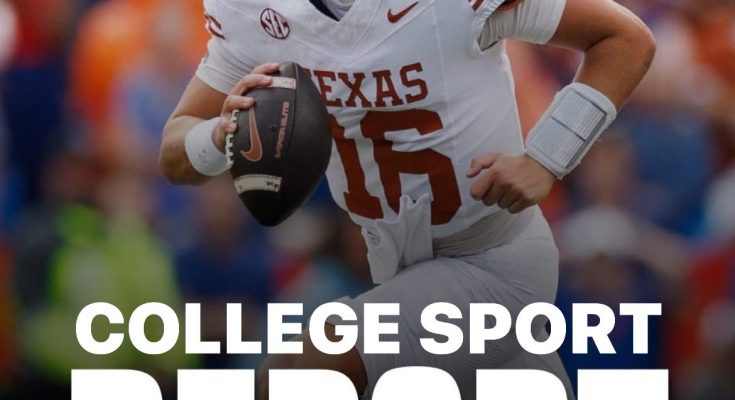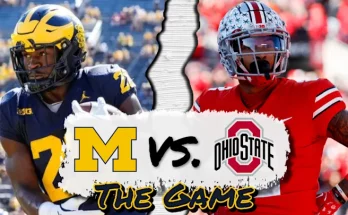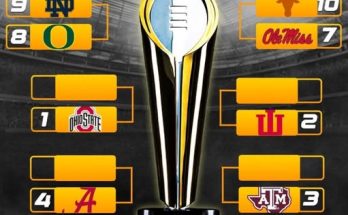The Texas Longhorns began this college football season surrounded by the kind of hope, hype, and high expectations that only a program with their storied past could command. Ranked preseason No. 1, the Longhorns entered the fall with dreams of reclaiming national glory, riding a wave of optimism that swept across Austin and beyond. The narrative was simple and seductive: Texas was back. After years of rebuilding, near-misses, and coaching turnovers, this was supposed to be the year the burnt orange burned brightest once again. Instead, what has unfolded over the past few weeks has been one of the most shocking collapses in modern college football history — a rapid and painful descent that has left the Longhorns not just out of playoff contention, but entirely out of the Associated Press Top 25 rankings.
With this fall, Texas becomes only the third team in the Top-25 era — and the first since the USC Trojans in 2012 — to tumble from the top of the mountain all the way out of the rankings within a single season after starting at No. 1. The sheer magnitude of that drop underscores just how stunning their collapse has been. For a program that prides itself on being “elite,” this is not just a disappointment; it’s an embarrassment that will be remembered for years to come.
When the preseason rankings were announced, the reasoning behind Texas’ lofty position seemed sound enough. The team returned a veteran quarterback with NFL potential, a stout offensive line, and a defense that was expected to mature into one of the best in the nation. The Longhorns were fresh off a strong recruiting cycle and carried momentum from their impressive bowl win the previous year. Many analysts believed that head coach Steve Sarkisian finally had all the pieces in place — a blend of experience, talent, and leadership — to guide Texas back to national prominence. The Big 12, soon to be a memory as Texas prepared to transition to the SEC, looked ripe for the taking. Everything pointed toward a golden season.
But the beauty and cruelty of college football lie in its unpredictability. The margin between triumph and disaster can be agonizingly thin, and for Texas, that truth hit hard. From the very first few games, cracks began to show. The offense, once projected to be explosive, sputtered in critical moments. The defense, heralded as disciplined and physical, showed inconsistency and a frustrating inability to finish games. Missed tackles, blown coverages, and unforced errors became all too familiar.
Early in the season, the Longhorns managed to scrape together a few wins, though not without warning signs. Their victory margins were narrow, their play uneven. The fanbase still believed, telling themselves the best teams sometimes start slow. But then came the losses — painful, avoidable, and demoralizing. A shocking defeat to an unranked opponent set off alarms, but what followed was even worse: a string of lackluster performances that stripped away the team’s confidence and identity. Each week seemed to bring new questions and fewer answers.
What makes this collapse particularly jarring is the psychological toll it has taken on the players, coaches, and fans alike. The Longhorns didn’t just lose games; they lost belief. They looked uninspired, outcoached, and, at times, overwhelmed. The same team that was supposed to symbolize Texas toughness now seemed to crumble under pressure. Games that should have been statements became postmortems.
The national media, initially quick to anoint Texas as a championship contender, turned skeptical and then openly critical. Pundits began to dissect what went wrong: Was the preseason ranking premature? Were expectations unfair? Did the coaching staff fail to adapt? The answers to those questions vary depending on whom you ask, but one thing is certain — Texas’ downfall is a cautionary tale about the dangers of hype and the weight of expectation.
There’s also a deeper, systemic issue that the program can no longer ignore. Texas football has been chasing its former glory for well over a decade. Since the days of Vince Young and Colt McCoy, the Longhorns have been desperate to recapture the magic that made them perennial national title contenders. Coaching changes, recruiting overhauls, and facility upgrades have come and gone, yet the results remain inconsistent. This season’s collapse is not an isolated event; it’s part of a troubling pattern. Texas has too often been a team that looks like a giant on paper but plays like a pretender on Saturdays.
For head coach Steve Sarkisian, this latest failure is particularly damning. When he took over, he promised to restore discipline, accountability, and a winning culture. Early on, it appeared he was succeeding — Texas recruited well, competed in big games, and developed star players. But the collapse raises serious questions about his ability to maintain consistency and mental toughness within the locker room. Being a great recruiter and offensive mind is one thing; being the leader who steadies a sinking ship is another.
It’s not just the coaches and players who are feeling the sting. The Longhorns’ fanbase, one of the most passionate and demanding in college football, has endured years of frustration. The preseason excitement that filled Darrell K Royal–Texas Memorial Stadium now feels like a cruel setup for heartbreak. The chants of “Texas is back” have once again been silenced by the harsh reality that the program remains trapped in mediocrity.
Critics have pointed out that this isn’t merely about one bad season — it’s about a culture that has prioritized image over substance. The Longhorns have the money, the facilities, and the resources to compete with anyone, but what they’ve lacked is cohesion and humility. When players buy into their own hype before proving anything on the field, the fall becomes inevitable. The preseason No. 1 ranking, in hindsight, may have done more harm than good. It added pressure to a team that had not yet learned how to sustain success.
Looking back at the USC Trojans in 2012 — the last team before Texas to suffer such a fall — the parallels are striking. That USC team was loaded with talent, led by a Heisman-caliber quarterback, and burdened with sky-high expectations. They, too, started the season at No. 1 before collapsing under the weight of their own hype, finishing outside the rankings. Like Texas, USC discovered that talent alone isn’t enough. Without discipline, focus, and resilience, even the most gifted rosters can unravel.
For Texas, the challenge now is to rebuild — not just the team’s record, but its identity. They must rediscover what it means to play with pride, grit, and humility. The transition to the SEC next season adds even more urgency to this process. If the Longhorns can’t find consistency in the Big 12, how will they fare against Alabama, Georgia, and LSU? The path forward will require not only new strategies but also a cultural reset.
Sarkisian’s job security, for now, seems intact, but the pressure will be immense. Athletic director Chris Del Conte and the university leadership have invested heavily in making Texas a football powerhouse again. Donors, alumni, and fans will demand accountability. A losing season for a team that began at No. 1 is more than just a blemish — it’s a crisis of confidence.
Still, amid the wreckage, there is room for hope. Football, especially at the college level, is cyclical. Programs rise, fall, and rise again. The same narrative that now paints Texas as a cautionary tale could, in a year or two, transform into one of redemption. The Longhorns still possess a deep talent pool, a strong recruiting foundation, and the financial might to compete with any school in the nation. What they need most is direction — and the humility to rebuild from the ground up.
For the players, especially the upperclassmen who have endured the highs and lows of the program, this season will leave scars. But it can also serve as a turning point. Teams often grow stronger from adversity. The challenge will be to channel the frustration of this historic collapse into motivation for the future.
College football is unforgiving, but it’s also defined by second chances. The same fans who now criticize the Longhorns will fill the stands again next season, hoping for a different outcome. The same media that mocks their fall will be ready to celebrate their resurgence. The only question is whether Texas can learn from this humiliation and finally live up to its promise.
For now, though, the numbers don’t lie. The Texas Longhorns, once perched atop the rankings and brimming with confidence, are out of the Top 25 entirely. They join a short and infamous list of teams that began at No. 1 only to plummet into irrelevance within the same season. It’s a bitter pill to swallow for a proud program that measures itself by championships and tradition.
As the dust settles, one truth remains clear: Texas may have the resources and the reputation, but until the results match the rhetoric, “Texas is back” will remain a hollow slogan. This season’s collapse is not just a stumble — it’s a reckoning. And whether the Longhorns rise from it or remain trapped in mediocrity will define the next era of Texas football.
In the end, the story of the 2025 Texas Longhorns will be remembered as a cautionary tale of hubris, hype, and heartbreak — a reminder that in college football, respect is earned on the field, not bestowed in August rankings. The Longhorns entered the season believing they were kings; they leave it searching for their crown.



